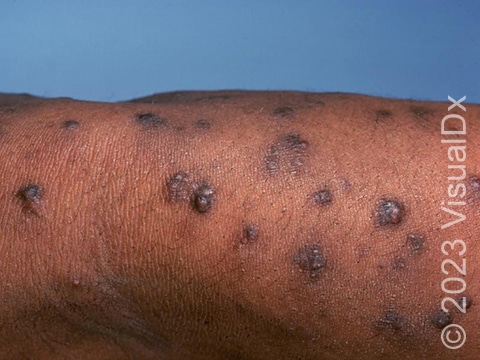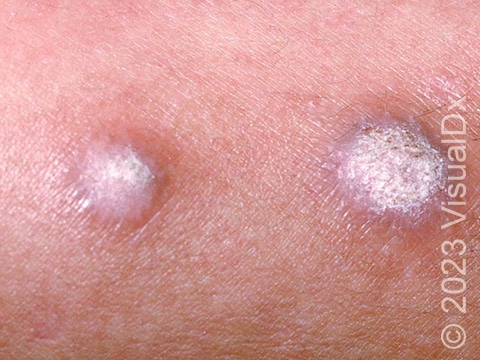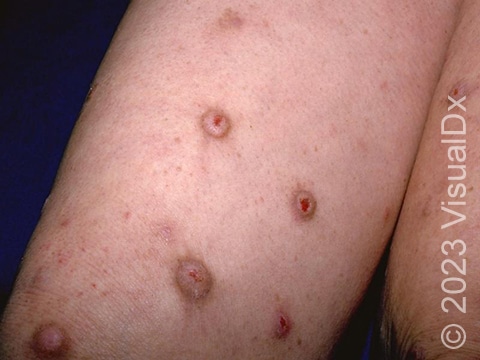
Prurigo Nodularis
Prurigo nodularis is a condition of extremely itchy papules (small, solid bumps) or nodules (solid, raised bumps that are firm to the touch) on the skin that may have a scab from scratching or picking. The lesions range in size but are generally smaller than a thumbnail. They can enlarge slowly over time. In some cases, there may be no itching, but uncontrollable picking or rubbing is the cause.
It is sometimes associated with another chronic skin condition, such as generalized itching or atopic dermatitis (eczema). It can also occur in people with illnesses that involve severe itching.
Prurigo nodularis can be a long-term (chronic) problem that lasts for many years. When an underlying medical or psychiatric condition is the cause of the itching, it often resolves with appropriate treatment of the condition.
Who's At Risk?
Prurigo nodularis can occur in people of all ages, but it mainly affects middle-aged to elderly people and is more common in women.
This condition can also occur in people with psychiatric disorders, eating disorders, HIV infection, kidney or liver problems, and cancers because all of these illnesses can involve severe itching.
Prurigo nodularis can also occur with other itchy skin conditions such as eczema.
Signs & Symptoms
There may be many small or large bumps on the skin, especially on the trunk, backs of the arms, thighs, and legs. The bumps appear as sores, and they may be covered with a layer of scaly or crusted skin. There is often no rash on the areas of the body that are difficult to reach, such as the mid-upper back.
In lighter skin colors, the lesions may be any shade of pink or red. In darker skin colors, redness can be difficult to see or may appear purple, dark brown, or gray. Areas of intense itching usually appear darker (hyperpigmented) than other parts of the skin. This hyperpigmentation is more common and often lasts longer in darker skin colors.
Scratching the bumps can lead to open sores, where bacteria can enter and cause an infection.
Self-Care Guidelines
The best self-care tip for people with prurigo nodularis is to avoid scratching the lesions. Scratching releases histamine in the skin that makes them itch even more. This, in turn, can lead to a vicious cycle of more scratching and more itching, known as the “itch-scratch cycle.”
Keeping your nails short, wearing gloves at night, and wearing bandages over the bumps that itch the most can limit the damage from scratching.
Using soothing creams (such as those containing menthol, pramoxine, or camphor) applied once or twice a day can help control the itch, as can over-the-counter antihistamines (like diphenhydramine [Benadryl]) taken at night.
For mild cases of prurigo nodularis, over-the-counter hydrocortisone cream (eg, Cortaid) can be applied. Usually, though, stronger steroids prescribed by a medical professional are needed.
Treatments
The medical professional may explain that even with treatment, prurigo nodularis is a challenging condition to control because of the severe itching involved and the difficultly with stopping the picking or rubbing.
There are several options for treating prurigo nodularis.
Topical treatment:
- Corticosteroids – Topical steroid creams or ointments can be prescribed for the lesions.
Steroids come in different strengths, and your health care professional will prescribe based on the severity and location of your skin lesions. Your medical professional may recommend putting tape or bandages already containing the steroids over the bumps.
Oral medication, injections, and other treatments:
- Oral antihistamines and other medication classes can be used to help control the itching and constant picking.
- Steroid medications can be injected directly into the bumps, which can be helpful in reducing the itch.
- Cryotherapy is a treatment that involves freezing the bumps to make them appear smaller.
- Phototherapy is a treatment that uses light similar to sunlight. This therapy has been used to treat lesions that are all over the body (widespread). It can require several sessions with your dermatologist to see results.
- Dupilumab (Dupixent) or nemolizumab (Nemluvio), injected under the skin (subcutaneously), may be used for severe cases.
- Antibiotic ointments or an oral antibiotic may be used if any of the affected areas become infected.
- Antidepressants and antiepileptics may lead to some improvement.
Visit Urgency
See a medical professional if the itch-scratch cycle seems unbearable, you can’t stop picking, or if there is a possibility of infection.
Having prurigo nodularis may suggest that there is another disease going on in the body that needs attention and treatment.
References
Bolognia J, Schaffer JV, Cerroni L. Dermatology. 4th ed. Philadelphia, PA: Elsevier; 2018.
James WD, Elston D, Treat JR, Rosenbach MA. Andrew’s Diseases of the Skin. 13th ed. Philadelphia, PA: Elsevier; 2019.
Kang S, Amagai M, Bruckner AL, et al. Fitzpatrick’s Dermatology. 9th ed. New York, NY: McGraw-Hill Education; 2019.
Last modified on September 17th, 2024 at 12:25 pm

Not sure what to look for?
Try our new Rash and Skin Condition Finder



